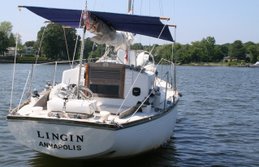We were successful in winning the third WNR of the first series this year. The conditions were 6-8 kts out of the south with limited seas.
When we come to the
The start was key to getting out ahead. As we all know, you need to have clear air and speed (or momentum) for a good Alberg start. As we neared the start time, the wind seemed to languish a bit, so we stayed very near the line.
A key to a successful start is to sight the line. To do this, before the start, sail outside the pin end of the line and sight the pin, the flag on the committee boat and something on shore. When you are starting, you can sight the flag on the committee boat and the thing on shore to know how close you are to the line. Take care to be aware if the committee moved the line between your sighting and the start!
We started mid-line to keep clear air and make it easier to ensure we had speed. After two tacks up to the first mark, we decided to stay high of the course to the next mark. One of the big boat starts had been recalled and restarted after us. (We are usually the last class to start since we’re slow.) They were now rolling over us and by staying high we were able to keep clear air and speed, even though we sailed a longer distance.
Rounding the next mark, we had to head to an inflatable mark toward Tolly Point, making this leg a beat. We were tempted to tack as soon as we rounded—here’s why: we rounded on starboard tack coming off a reach and rounding up to close hauled. The big boats coming behind us point better than we can and are on starboard as they come around. We’ve been pinned down after the rounding, unable to tack onto port and cross the line of big boats and unable to point high enough to keep clear air.
This time the rounding was a bit different, though. We felt we would not get rolled too badly by the big boats, and we wanted to get out toward the Bay as soon as possible. We felt there would be a lift as the wind bends around Tolly and it looked like there was better pressure out there. This was a bit risky as we watched Argo and Skybird tack after rounding the mark. We managed the risk by tacking about half way up the beat and loosely covering them. I’m not sure we made out much by going left, but we seemed to hold our lead.
From that mark we popped the chute and the LinGin crew worked hard to keep us going as fast as possible. One thing you quickly learn in the WNR is that a lead out in the river can QUICKLY be erased in the harbor as the wind drops significantly and the boats behind catch up. You can’t relax until you’ve crossed that line!
--Tim


No comments:
Post a Comment